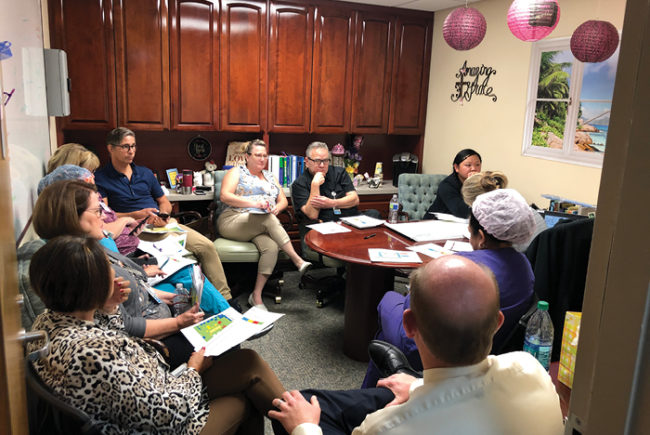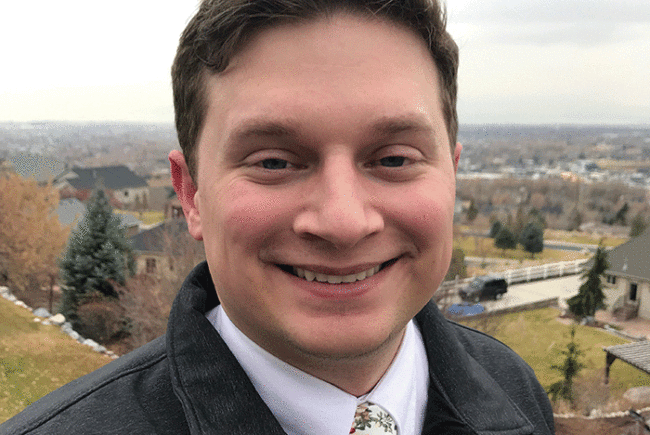
Image by Getty Images
It’s an everyday occurrence: An inspector measures the space under a hallway door in a hospital, finds that the clearance is a bit too wide and makes an observation. Problems with doors — including clearance issues — were the fifth most commonly observed issues in Joint Commission surveys in 2015.
Because door clearance issues get that much attention, one might assume a lot of research backs up the recommended clearances. Leaders of the American Society for Health Care Engineering (ASHE) wondered about that, and joined three other organizations to sponsor research through the Fire Protection Research Foundation (FPRF) into the door-gap issue.
FPRF, which is affiliated with the National Fire Protection Association (NFPA), investigated the history of the door-gap standards in NFPA 80, Standard for Fire Doors and Other Opening Protectives, and found that the door-gap standard was first introduced in 1959 and was last revised in 2016. How much research backed up the requirements? This is what the researchers determined:
“Throughout all of these changes, the technical committee records do not seem to show any supporting technical/scientific justification for the NFPA 80 clearance dimensions.”
In other words, no actual research backs up that standard.
“The study identified a lack of full-scale fire testing regarding the door-gap standards,” confirms Chad Beebe, FASHE, ASHE’s deputy executive director.
The door-clearance standard is just one of thousands of codes and regulations that affect hospital construction. How many of them lack supporting research? Nobody knows for sure but, considering how much effort and capital are exerted to comply with these standards, it’s understandable that people involved with health care facilities are interested.
Resources
“This is something we’ve identified for the past 10 to 12 years as one of our values,” Beebe says. “We’ve decided as an organization that we want to be regulated by good codes and standards that are backed up by good data.”
Why it matters
The process for creating the codes and standards that regulate health care facilities is rigorous, with lengthy reviews and thousands of expert opinions. So, is it really important that many codes are not backed up by research?
“It’s not that these numbers [in the codes and standards] are wrong and health care organizations should just go do their own thing,” says Doug Erickson, FASHE, CEO of the Facility Guidelines Institute (FGI). “Many are legacy values and have been established from a collection of very intelligent, seasoned engineers and clinical experts who evaluate them. So, to get rid of them simply because they’re not validated by research would be a monumental faux pas.”
Beebe backs that up: “Just because there’s not science behind a requirement doesn’t mean it’s not good.”
But, say those who are advocating for more data-based standards, research might show that the standards are incorrect or that a less strict standard will not affect safety.
For example, what if research shows that door gaps could be one-eighth inch wider than they currently are without any increase in fire risk? Then, presumably, the inspectors could stop citing so many hospitals for that problem. And if the research confirms the scientific validity of the standard, or leads to even stricter standards, so be it.
“Either way, we’re fine,” Beebe says. “We don’t want to arbitrarily influence the codes and standards. We want to do the right thing for patient and staff safety.”
From a practical standpoint, having data to back up the standards also could quiet critics. For example, Erickson says that one large health care system is challenging FGI and the American Society of Heating, Refrigerating and Air-Conditioning Engineers (ASHRAE) to back up its ventilation standards with data.
“They would like to reduce total air changes in rooms to save energy,” Erickson says. “It’s a fiscal bottom-line issue with them. Their claim is, ‘If there’s no strong evidence, we don’t think we should have to meet regulations not substantiated by research or science.’”
How much research is there?
ASHRAE recently funded a study to examine what research backs up ASHRAE Standard 170, Ventilation of Health Care Facilities, which is incorporated into the FGI Guidelines and is referenced by NFPA 99, Health Care Facilities Code, which is adopted by the Centers for Medicare & Medicaid Services (CMS). The study leaders did a comprehensive literature review to uncover any research supporting the 886 requirements in ASHRAE 170.
Some of the requirements are obvious and don’t need backup research — for example, “6.5.2: If radiant cooling panels are utilized, the chilled-water temperature shall always remain above the dew-point temperature of the space.” But of the 719 remaining requirements, 651 had insufficient data to support them, the study found.
Because of how codes and standards that affect health care facilities were established and have grown over the decades, it’s not surprising that few are backed up by solid research.
Erickson says he raised that issue with a national expert on health care ventilation and his comment was, “‘Do you have hundreds of millions of dollars to spend and 20 years of time?’” Erickson says. “There are so many variables and so many things we don’t know, it’s almost impossible to put numbers based on research behind all of the standards.”
How standards emerged
If research isn’t behind most of the standards that health care facilities need to follow, how did they come to be?
“It’s difficult to characterize in general how proposals for new or updated standards emerge,” says Michael Pfeiffer, senior vice president of technical services for the central regional office of the International Code Council (ICC). “Maybe a designer works on something year in and year out, and says, ‘Is this the best way to do this?’ Sometimes it’s advancements in technology, or someone just finds a better way to do something.”
Pfeiffer says another source of changes is tragedy. For example, the destruction of the World Trade Center in 2001 led to several important building-code changes, including the need for secondary water supplies for sprinkler systems and applying spray-on fireproofing on steel beams, Pfeiffer says.
More recently, the deadly fire in Grenfell Tower in North Kensington, West London, in 2017, prompted municipalities around the world to revise standards regarding testing exterior wall envelopes when they contain combustible material.
“When something happens like the Grenfell tragedy, the first question people ask is, ‘Could that have occurred in our current environment?’” Pfeiffer says. “So that causes people to do research on the requirements.”
Jonathan Hart, SASHE, principal engineer for the NFPA, concurs with Pfeiffer: “If you looked at the NFPA codes and standards, probably a good deal of them are not from any specific research. But many of them are from fire investigations.”
Research that’s underway
Research doesn’t back up every code, but these days there is some research going on in the field. Some of it supports existing codes, and some leads to changes.
The FPRF funds about a dozen research projects each year, Hart says. “Those research projects support the technical committees [whose members write the codes],” he explains. “A lot of times, someone will suggest a change, and the committee says, ‘We don’t have enough information on this.’ So, they’ll ask for it from the foundation.”
For example, FPRF supported a 2014 study that investigated the idea of expanding the allowable size of smoke compartments in health care facilities from 22,500 square feet to 40,000 square feet. ASHE supported the change, and asserted that the larger size would provide flexibility to the designer and increase patient safety. The research provided the committee with the information needed to determine the impact to the fire risk.
“The change was still met with resistance by some, but the research made the technical committee comfortable enough to go with that size, and it passed into the 2018 edition of the code,” according to Hart.
Another recent FPRF study focused on the frequency of testing fire-protection systems.
The foreword to the study, published in July, explicitly acknowledges that many existing codes are not backed up by data: “These are often historical requirements that are not based on ITM [inspection, testing and maintenance] data or on observed deficiencies. As NFPA develops new documents that involve integrated systems, the need for a more data-based approach to ITM frequencies will be important.”
The study, which was backed by ASHE, concluded that performance-based criteria for the frequency of testing fire-protection systems could be established using a predictive-failure model. In other words, standards should use science to determine how often something needs to be tested.
“We do a lot of inspection testing and maintenance, and the question comes up [as to whether] doing that much maintenance has wear and tear on the equipment,” Beebe notes. “How do you find the balance between inspecting and maintaining equipment at a frequency that improves reliability without damaging the equipment?”
ASHE’s own research also can affect codes. Jonathan Flannery, FASHE, senior associate director of advocacy for ASHE, remembers that CMS proposed changing the requirement for emergency-generator testing from once every three years to once a year.
“Their justification was that generators are so important that testing needs to be done every year,” Flannery says. “We had done a survey of members regarding emergency-power systems, and we were able to show that they are 96 percent reliable, and that half of the failures were due to the automatic-transfer switch, not the generator itself. Because of that research, CMS agreed that we don’t have to increase testing.”
A lot of research that makes its way to code development comes from manufacturers, Erickson adds.
For example, a manufacturer developed a humidification process using an adiabatic method, which provides moisture to the air in liquid form. The code required steam humidification, but the research by the manufacturer — which showed that adiabatic humidification was just as safe as steam humidification but used less energy — persuaded the appropriate ASHRAE committee to allow it.
Other sources of research also affect health care facilities codes, including some done by students pursuing Ph.D.s and some conducted by government agencies, such as the National Institutes of Health.
Despite these examples, Beebe says the need for more research sources is undeniable.
“We’re just trying to pick the lower-hanging fruit with the research that we’re supporting right now,” he says. “We look at the items that are cited most often in inspections, and see if we can influence them based on the research. But there is a lot more to do.”
Ed Avis is a freelance writer and a regular Health Facilities Management contributor based in Chicago.




